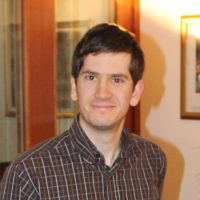Filippo STELLIN
In this research project, carried out between the 1st October 2016 and the 15th June 2020, I have theoretically investigated the behaviour of quantum particles (electrons, atoms, photons, etc.) moving in a random medium and undergoing Anderson localization. For noninteracting particles, the energy spectrum can possess one or more critical points, where the nature of the single-particle wavefunctions changes from extended to localized leading to a metal-insulator phase transition, also known as Anderson transition.
A fundamental question is whether and how Anderson transitions survive in interacting quantum systems. Here I have studied a minimal model of two particles moving in a disordered lattice and subject to short-range mutual interactions. By combining large-scale numerics with Green’s functions techniques, I have shown that two-particle Anderson transitions do occur in three dimensions and explore the phase diagram in the space of energy, disorder and interaction strength. The latter presents a rich structure, characterized by a doubly reentrant behavior, caused by the competion between scattering and bound states of the pair. I have also shown that previous claims of 2D Anderson transitions of the pair are essentially due to finite-size effects.
A second problem that I have addressed in this thesis is the occurrence of 2D metal-insulator transitions for a single particle in the presence of a spatially correlated potential and subject to spin-orbit interactions, described by Rashba-Dresselhaus couplings. I have illustrated that, irrespective of the properties of the disorder, there is a regime where the critical energy Ec depends linearly on the disorder strength. The slope and the intercept have been studied in the vicinity of the spin-helix point, where the SU(2) symmetry is restored and the 2D metal-insulator transition disappears.
